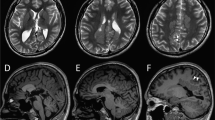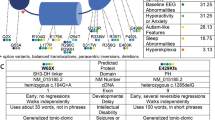Abstract
We performed genomic mapping of a family with autosomal dominant nocturnal frontal lobe epilepsy (ADNFLE) and intellectual and psychiatric problems, identifying a disease-associated region on chromosome 9q34.3. Whole-exome sequencing identified a mutation in KCNT1, encoding a sodium-gated potassium channel subunit. KCNT1 mutations were identified in two additional families and a sporadic case with severe ADNFLE and psychiatric features. These findings implicate the sodium-gated potassium channel complex in ADNFLE and, more broadly, in the pathogenesis of focal epilepsies.
This is a preview of subscription content, access via your institution
Access options
Subscribe to this journal
Receive 12 print issues and online access
$209.00 per year
only $17.42 per issue
Buy this article
- Purchase on Springer Link
- Instant access to full article PDF
Prices may be subject to local taxes which are calculated during checkout

Similar content being viewed by others
Accession codes
References
Scheffer, I.E. et al. Brain 118, 61–73 (1995).
Heron, S.E., Scheffer, I.E., Berkovic, S.F., Dibbens, L.M. & Mulley, J.C. Neurotherapeutics 4, 295–304 (2007).
Rodrigues-Pinguet, N. et al. J. Physiol. (Lond.) 550, 11–26 (2003).
Aridon, P. et al. Am. J. Hum. Genet. 79, 342–350 (2006).
Hoda, J.-C. Mol. Pharmacol. 74, 379–391 (2008).
Derry, C.P. et al. Epilepsia 49, 2125–2129 (2008).
Reid, C.A., Berkovic, S.F. & Petrou, S. Prog. Neurobiol. 87, 41–57 (2009).
Khatami, R., Neumann, M., Schulz, H. & Kölmel, H.-W. J. Neurol. 245, 809–810 (1998).
Magnusson, A., Stordal, E., Brodtkorb, E. & Steinlein, O. Psychiatr. Genet. 13, 91–95 (2003).
Bhattacharjee, A., Gan, L. & Kaczmarek, L.K. J. Comp. Neurol. 454, 241–254 (2002).
Bhattacharjee, A., von Hehn, C.A., Mei, X. & Kaczmarek, L.K. J. Comp. Neurol. 484, 80–92 (2005).
Chen, H. et al. J. Neurosci. 29, 5654–5665 (2009).
Tamsett, T.J., Picchione, K.E. & Bhattacharjee, A. J. Neurosci. 29, 5127–5134 (2009).
Plazzi, G., Tinuper, P., Montagna, P., Provini, F. & Lugaresi, E. Sleep 18, 749–756 (1995).
Acknowledgements
We thank the affected individuals and their families for their participation in this study, and B. Johns and R. Schultz for technical assistance. This work was supported by the National Health and Medical Research Council of Australia (Program Grant 628952 to S.F.B., I.E.S., S.P. and L.M.D., Program Grant 490037 to M.B., Training Fellowship 1016715 to S.E.H., Senior Research Fellowship 1005050 to S.P., Australia Fellowship 466671 to S.F.B., Practitioner Fellowship 1006110 to I.E.S. and Career Development Fellowship 1032603 to L.M.D.). The Florey Institute of Neuroscience and Mental Health is supported by Victorian State government infrastructure funds. K.R.S. is supported by a PhD scholarship funded by the Pratt Foundation. M.B. is supported by Australian Research Council Future Fellowship FT100100764. Work by K.R.S. and M.B. was also supported by Victorian State Government Operational Infrastructure and Australian Government National Health and Medical Research Council Independent Research Institutes Infrastructure Support Scheme (IRIISS) funding. The study was approved by the Human Research Ethics Committees of Austin Health and the University of South Australia. Informed consent was obtained from all participants or their parents or guardians.
Author information
Authors and Affiliations
Contributions
S.E.H. analyzed whole-exome sequencing data, and designed and performed the molecular genetic aspects of the project. K.R.S. performed linkage analysis. M.B. supervised linkage analysis. K.L.O. and L.L. collated and analyzed clinical data. G.P., L.N., E.K., A.M., Z.A., A.K. and I.E.S. identified families and provided clinical information. S.P. contributed to discussions on the functional effects of the mutations. L.M.D. designed and oversaw the study. S.E.H., I.E.S., S.F.B. and L.M.D. wrote the manuscript.
Corresponding author
Ethics declarations
Competing interests
The authors declare no competing financial interests.
Supplementary information
Supplementary Text and Figures
Supplementary Methods, Supplementary Table 1 and Supplementary Figure 1 (PDF 159 kb)
Rights and permissions
About this article
Cite this article
Heron, S., Smith, K., Bahlo, M. et al. Missense mutations in the sodium-gated potassium channel gene KCNT1 cause severe autosomal dominant nocturnal frontal lobe epilepsy. Nat Genet 44, 1188–1190 (2012). https://doi.org/10.1038/ng.2440
Received:
Accepted:
Published:
Issue Date:
DOI: https://doi.org/10.1038/ng.2440
This article is cited by
-
Parasomnien bei Kindern und Erwachsenen als Differenzialdiagnose zu nichtläsionellen fokalen Epilepsien
Clinical Epileptology (2023)
-
Parasomnia in children and adults as a differential diagnosis to non-lesional focal epilepsy—English version
Clinical Epileptology (2023)
-
New use for an old drug: quinidine in KCNT1-related epilepsy therapy
Neurological Sciences (2023)
-
Rare variants in GABRG2 associated with sleep-related hypermotor epilepsy
Journal of Neurology (2022)
-
Genetic syndromes associated with frontal lobe epilepsy
Zeitschrift für Epileptologie (2022)



